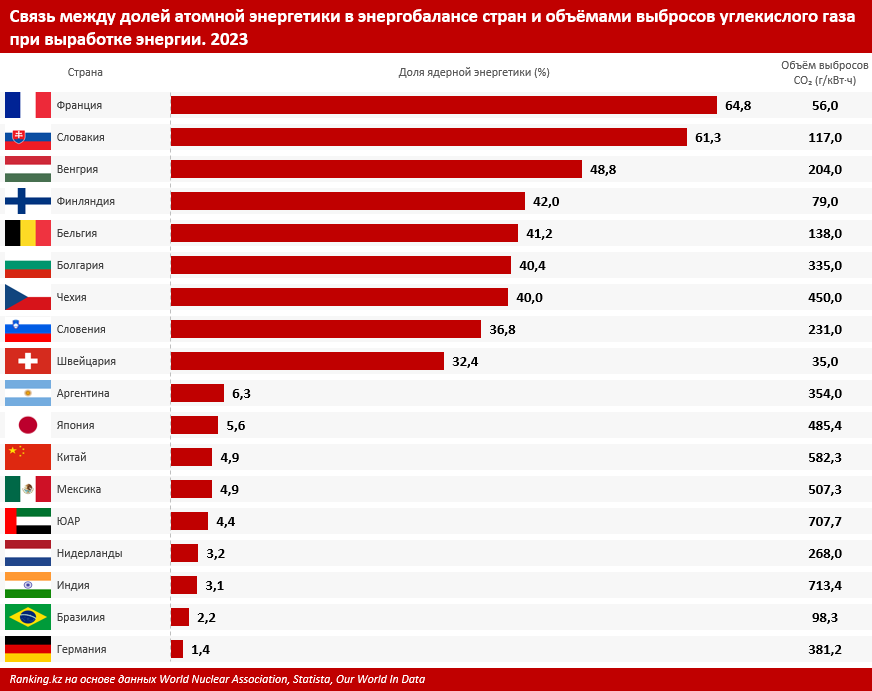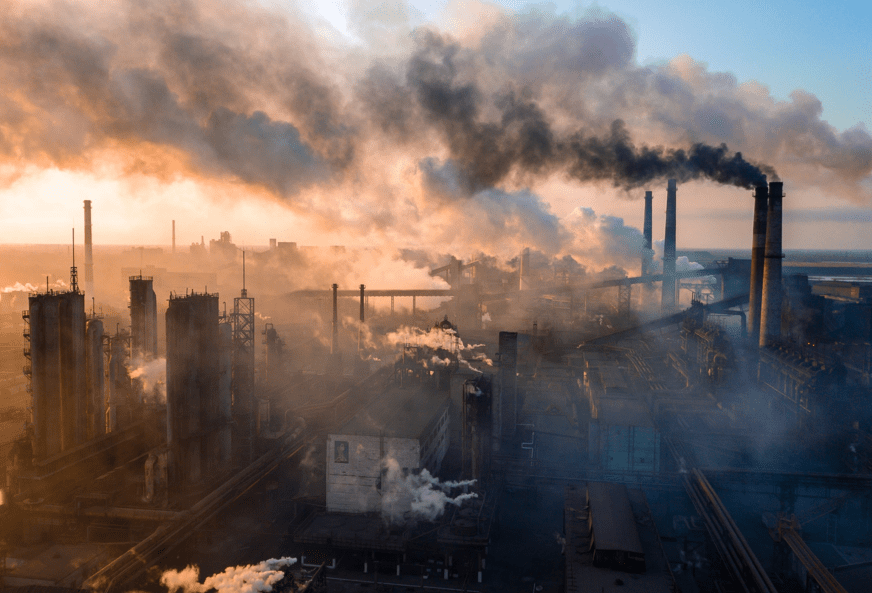Climate change is one of the most serious threats of our time, and carbon emissions play a key role in this process. Since 2015, when the Paris Agreement was signed, the international community has been actively looking for ways to reduce greenhouse gas emissions. To date, 194 countries, including Kazakhstan, have committed to reducing their carbon footprint. In this context, nuclear energy is an important tool for achieving climate goals and the transition to sustainable development.
Carbon dioxide (CO₂) emissions from the energy sector account for more than 40% of all global emissions, making it one of the most pressing issues in the fight against climate change. The main sources of carbon emissions include:
Coal: One of the most carbon-intensive energy sources, emitting 800–1,000 grams of CO₂ per kilowatt-hour (g/kWh). While coal remains an important source of electricity, its negative environmental impacts are driving the search for alternatives.
Natural gas: Although its carbon footprint is 400–500 g/kWh, methane leaks during production and transportation add to the overall negative climate impact.
Renewable energy sources. Solar and wind energy are significantly less carbon intensive, with emissions of 20–50 and 11–12 g/kWh, respectively. However, dependence on weather conditions and the need to create backup capacity can increase the carbon footprint.
Nuclear power. CO₂ emissions from nuclear power plants are only 5.1–6.4 g/kWh, making nuclear power one of the cleanest ways to produce electricity.
Global experience shows that countries with a high level of nuclear energy development have significantly lower carbon emissions. For example, France, where about 65% of electricity is produced at nuclear power plants, has some of the lowest CO₂ emissions in the world – only 56 g/kWh. This shows that increasing the share of nuclear energy in the country’s energy balance can significantly reduce carbon emissions.
At the COP-28 conference in 2023, 20 countries, including the United States and France, signed a declaration to triple nuclear power generation capacity by 2050. The European Parliament also voted to include nuclear energy in the taxonomy of “green” energy, which opens up new prospects for the development of nuclear energy in Europe and the world.
Kazakhstan, with its large uranium reserves and experience in nuclear energy, is well positioned to use nuclear energy as a key tool for reducing carbon emissions.
Источник: https://ranking.kz/reviews/industries/parizhskoe-soglashenie-i-parnikovye-gazy-kakie-istochniki-energii-vyzyvayut-bolshe-vsego-vybrosov-co2.html

Now let’s look at global experience using examples.
France .
France is a shining example of the successful use of nuclear energy to reduce carbon emissions. As a result of the rapid development of nuclear energy in the 1970s, the country was able to provide about 65% of its electricity through nuclear power plants. This decision contributed to a significant reduction in CO₂ emissions, making France one of the leaders in clean energy production in the world.
According to data, France’s GDP grew by an average of 5% per year in the 1970s, demonstrating dynamic economic growth despite the introduction of new technologies and energy solutions. At the same time, CO₂ emissions per capita have decreased by almost 40% since 1970, a result of the transition to nuclear energy and increased energy efficiency. This combination of economic growth and reduction of carbon emissions makes France a unique example of how sustainable development can be achieved through the introduction of nuclear energy.
USA .
According to the declaration signed at COP-28, the United States is once again focusing on the development of nuclear energy, understanding the importance of this industry for achieving energy independence and reducing carbon emissions. In recent decades, American nuclear energy has faced various challenges, including the aging of existing reactors and negative public perception. However, the awareness of the need for a sustainable energy future and the desire for decarbonization are opening new horizons for nuclear energy in the country.
The U.S. Department of Energy (DOE) actively supports the development of new technologies such as small modular reactors (SMRs). These reactors offer a number of advantages, including improved safety, modularity, and the ability to be deployed more flexibly depending on regional needs. As part of its strategies, DOE emphasizes that SMRs can be key elements in providing reliable and clean energy, which is especially important for achieving climate and sustainable development goals.
The return to nuclear energy in the United States is also linked to the need to strengthen energy independence. Drawing on the lessons of the past, when the country weakened its position in the nuclear sphere, a new generation of politicians and experts recognizes that nuclear energy can significantly reduce dependence on imported fossil fuels. As a result, the United States is seeking not only to increase nuclear generation capacity, but also to regain leadership in global nuclear energy, thereby ensuring energy security and supporting international climate commitments.
Germany .
Despite Germany’s commitment to completely phase out nuclear power, the move has been seen by many experts as hasty and possibly strategically disadvantageous. In 2011, following the Fukushima disaster, Germany decided to shut down its nuclear power plants by 2022, even though they were providing a significant portion of the country’s low-carbon electricity at the time. Instead, the country has aggressively pursued renewable energy sources such as wind and solar. However, this abrupt change in energy strategy has had a number of consequences.
First, the transition to renewable energy has proven challenging in terms of energy supply stability. Temporary gaps in renewable energy generation have forced Germany to rely more on coal and natural gas, which in turn has increased CO₂ emissions. The hasty phase-out of nuclear energy without a proper transition plan has meant that the country has lost a powerful tool for combating climate change. Nuclear energy, being low-carbon and stable, could have played a key role in the transition to a sustainable energy system, but its withdrawal has increased Germany’s carbon footprint.
In countries with a low share of nuclear energy, such as South Africa (4.4%) and India (3.1%), CO₂ emissions remain significant: 707 and 713 g/kWh, respectively.
To significantly reduce emissions, decarbonisation of all energy sectors is necessary. However, the greatest attention is currently focused on the electricity sector for a number of reasons:
First, the electricity sector is the easiest to decarbonise because it can use low-carbon alternatives such as nuclear energy.
Secondly, electricity is clean at the end-use stage, which has two key benefits: improving air quality in urban areas and centralising emissions, making them easier to regulate.
Third, electricity production is an intensive source of CO₂ emissions. While only about 20% of final energy consumption is electricity, its production is responsible for more than 40% of all energy-related emissions.
Источник: https://ranking.kz/reviews/industries/parizhskoe-soglashenie-i-parnikovye-gazy-kakie-istochniki-energii-vyzyvayut-bolshe-vsego-vybrosov-co2.html

For Kazakhstan, the transition to low-carbon energy sources is extremely relevant, as the country ranks second in the world in terms of the largest volume of greenhouse gas emissions. According to the results of 2023, the volume of CO₂ emissions in Kazakhstan amounted to 821 g / kW h. The reason is that more than 77% of electricity in the country is generated at thermal power plants (TPPs) that run on coal.
Reducing such a volume of greenhouse gas emissions is possible only through the use of low-carbon energy sources, in our case, this is the introduction of a nuclear power plant (NPP). Kazakhstan has all the prerequisites for this: the country ranks second in the world in terms of proven reserves of natural uranium and is a leader in the uranium mining industry, annually covering about 40% of the world’s nuclear energy needs. An analogy can be drawn that at least every third nuclear reactor in the world operates on Kazakhstani uranium.
In addition, the National Atomic Company Kazatomprom operates in Kazakhstan, which is the largest producer of natural uranium with priority access to one of the world’s largest resource bases. Kazatomprom’s structure includes the Ulba-TVS LLP plant, which was launched in November 2021 after passing certification from the owner of the fuel assembly production technology, the French company Framatome, and receiving recognition as a certified supplier of nuclear fuel from the end user of the products, the Chinese nuclear corporation CGNPC. The Ulba-TVS plant allowed Kazakhstan to enter a limited circle of global suppliers of fuel assemblies, that is, finished nuclear fuel for nuclear power plants. This is the only production of nuclear fuel for nuclear power plants in Kazakhstan. Kazatomprom’s main clients are nuclear power plant operators, and the main export markets for its products are China, South and East Asia, North America and Europe.
Thus, if we talk about the potential launch of a nuclear power plant in Kazakhstan, Kazatomprom, based on its annual production volume, has more than sufficient uranium resources to meet the needs of a nuclear power plant.
All things considered, nuclear energy is an important tool for combating climate change and reducing carbon emissions. International experience, which has shown successful examples of using nuclear energy to reduce the carbon footprint, can serve as a guide for Kazakhstan. The construction of new nuclear power plants in the country will not only reduce CO₂ emissions, but also ensure energy security, economic growth and improve the quality of life of the population.
Источник: https://ranking.kz/reviews/industries/parizhskoe-soglashenie-i-parnikovye-gazy-kakie-istochniki-energii-vyzyvayut-bolshe-vsego-vybrosov-co2.html
Фото: https://www.shutterstock.com/

